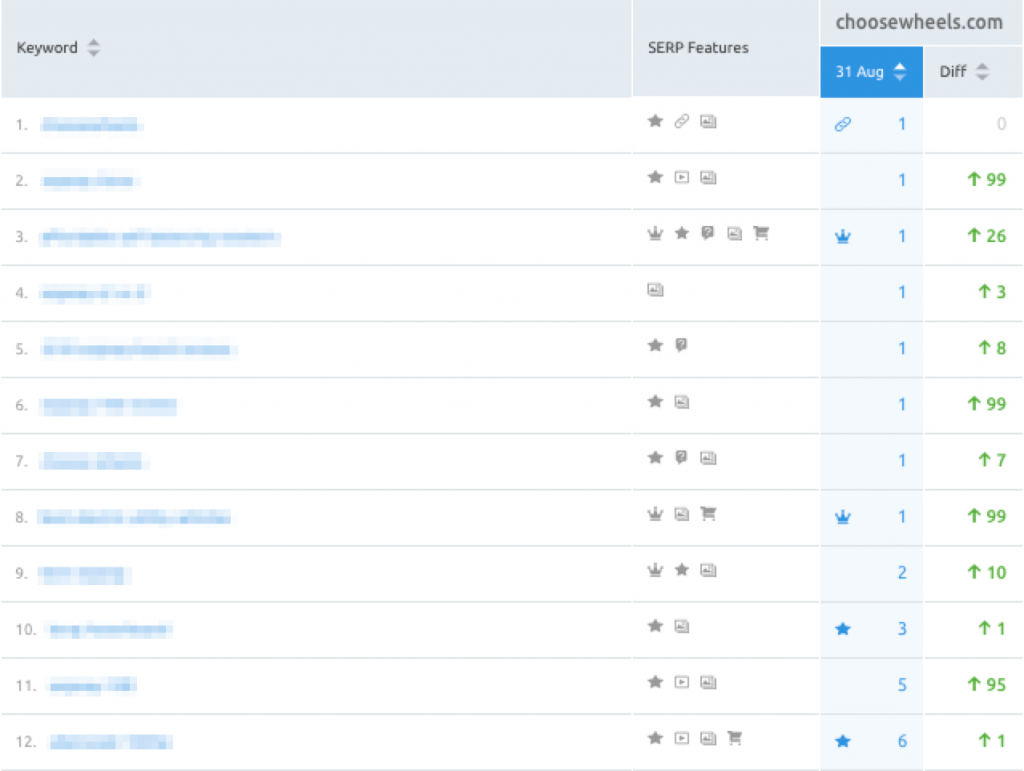- Marketing Strategy
- The Implementation Process
- The Results
Table of Contents
The team at Choose Wheels came to us with a problem. Their site had been hit with a manual penalty from Google and traffic was on the decline.
For those who aren’t familiar: Choose Wheels is a website that provides comprehensive guides on personal transportation devices (electric scooters, electric bikes, and much more). Their business model focuses on building partnerships with companies that sell these devices and collecting a portion of each sale that they help to generate.
Choose Wheels isn’t like most successful affiliate marketing websites. They don’t have a massive monthly ad spend. They don’t rely on sending people to landing pages through Facebook Ads to make money.
Instead, they rely on great content.
Choose Wheels focuses on educating their target readers through writing informative product reviews and other useful guides. Their affiliate program focuses on partnering with online retailers like Amazon and collect affiliate commissions when they help their customers to make an informed purchase. As a result, search engines have historically made up 70% of their total site traffic.
The previous site owner was involved in a private blog network (“PBN”, for short), which was uncovered by Google’s webspam team several months after the current owner took over.
Over the course of the next 2 months, Choose Wheels lost 80% of their organic traffic.

Choose Wheels came to us shortly after their penalty had been lifted to learn about our content marketing services and see how we could help recover some of their lost organic traffic.
This affiliate marketing case study delves into exactly what we accomplished together.
Marketing Strategy
We started with our Discovery Process to learn about their business goals, primary competitors, and more.
During our initial analysis, we identified 3 primary issues with the Choose Wheels site (in addition to the PBN penalty):
- We had a much weaker backlink profile than our primary 3 competitors
- Much of the content on the existing site was becoming outdated
- On-page metrics like bounce rate and average session duration were underperforming
We knew that we had an uphill battle ahead of us. Given these issues, our content marketing strategy consisted of the following action plan:
Short term:
- Write monthly blog articles that targeted long-tail search phrases (to drive more qualified visitors as we rebuilt our site authority)
- Revamp existing posts on the site with the greatest search ROI potential to maximize organic traffic and website conversions
Long term:
- Focus on building our site authority through targeted link outreach to relevant publishers
- Write quarterly premium blog articles that targeted high-value search phrases with a high search volume (to drive significant long-term search ROI as we scaled our site authority)
Related: learn about 9 actionable affiliate marketing SEO tactics that we use every day.
The Implementation Process
Kicking off the SEO foundation
We analyzed the competitive landscape to learn about the search positioning and top-performing content of our largest competitors. Next, we explored Reddit and Quora to see what topics our target customers were most interested in. With this, we built our editorial calendar for the first 6 months of content.
We optimized the 15 pages on the site with the highest potential for organic traffic improvements. We re-wrote title tags and meta descriptions; incorporated term frequency, inverse document frequency (TF-IDF); enhanced site speed, and much more.
Also see: 7 Common Mistakes Every Affiliate Marketer Needs to Avoid
Strategic content creation
Our content creation process started with targeting long-tail search terms that the Choose Wheels website would see immediate traction on.
We analyzed top-performing content for each topic to identify the key success factors for each post. Our team then published long-form articles and promoted them across relevant social communities.
One by one, our articles started to outrank authoritative sites in search results for high-value search terms.
Managing link outreach
We launched our first link building campaign to drive high-quality backlinks and boost our site authority.
This consisted of reaching out to 1,000 industry-leading bloggers who had written about or linked to content that was similar to our own. We started discussions and built relationships. In the process, we encouraged 10 of those bloggers to link to various articles on the site each quarter, and dozens more to share our articles on social media.
Revamping underperforming content
Next was the process of revamping underperforming content.
We used our Click-Through-Rate Calculator to identify the pages on the site that were losing out on the most organic traffic. In other words, our team found the pages that were seeing far fewer clicks than the industry average for their given position in search results.

We re-optimized title tags and meta descriptions for each of these to maximize the ROI of each of these rankings.
Next, our team looked at pages with a high bounce rate or low average session duration.
We broke up walls of text and revised outdated content to improve readability and usefulness to their target audience.
Related: download our content marketing playbook to see our step-by-step walkthrough of how to scale your online presence.
Organic traffic took a small dip in the first two months of partnering together as we built our SEO foundation and kicked off the first quarterly campaign.
However, everything started coming together in our 3rd month of working together.
We had implemented our SEO foundation, published our first 2 months of blog posts, began to revamp underperforming content, and kicked off our first link building campaign.
The result was that organic traffic climbed 20.2% in April 2018. It was clear that we were headed in the right direction.
The Results
We continued to implement our initial strategy for the next 4 months. Here’s what we’ve seen so far.
Target keyword visibility (how well Choose Wheels ranks for their top-priority keywords) has increased by 459%.

As target keyword rankings improved, so too did their monthly organic traffic. Organic traffic, which drives 76% of their total website traffic, is up 121% in 2018.

As a whole, website traffic has increased by 124% this year, as of August.

Related: think Choose Wheels is an outlier? See how content marketing helped another partner to grow 487.1% (so far).
One important thing to note is that massive increases in organic traffic often result in lower-quality site visitors. This can often be seen by worse bounce rates, average session durations, and conversion rates.
In the case of Choose Wheels, on-page performance saw massive improvements.

Bounce rate and average session duration improved by 15% and 40%, respectively. All the while goal conversions increased by 526%!
We couldn’t be more excited about the growth that Choose Wheels has seen since partnering with us.
Looking for a partner to help you scale your online business? Let’s see if we’re the right partner for you.
SCALE YOUR ORGANIC TRAFFIC
Subscribe to our monthly newsletter



